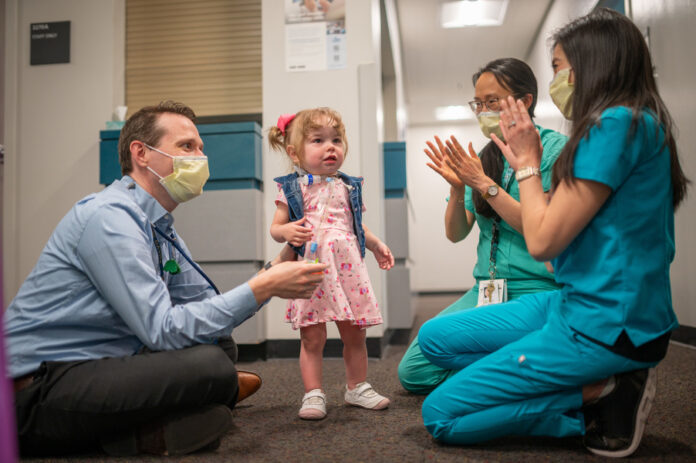Everly Jacobsen was diagnosed with an abnormally large omphalocele, a birth defect that only affects one in 5000 children
By BRANDON NGUYEN — science@theaggie.org
Born in 2020 with her internal organs protruding outside of her abdomen, Everly Jacobsen was diagnosed at UC Davis Health with a birth defect known as omphalocele, a condition that only affects one in every 5000 births. However, Everly’s omphalocele was larger than most omphaloceles, which is associated with higher mortality rates and a high risk of comorbidities.
Brianne Jacobsen, the mother of Everly Jacobsen and resident of the city of Redding above the Sacramento Valley, described feeling overwhelmed upon discovering her child’s condition through an ultrasound.
“As a first time parent along with the fact that it had taken us a while to get pregnant, I of course didn’t want anything to be wrong,” Jacobsen said. “So when I first found out about Everly’s condition, it was like a gut punch — lots of tears, lots of anxiety and I didn’t know what to do next.”
Fortunately, with the help of a multidisciplinary team of UC Davis Health professionals ranging from cardiologists, pulmonary hypertension physicians, pediatric surgeons, nurse practitioners and many more, Brianne’s anxiety turned into optimism. Robyn Huey Lao, a pediatric surgery outpatient nurse practitioner at UC Davis Medical Center, grew close to the Jacobsen family and supported Everly’s development throughout the process.
“All of Everly’s abdominal organs were encased in a membrane when she’s born, and hers was a giant omphalocele, three times what we usually observe in babies with this condition,” Lao said. “Usually the usual treatment is we just ‘paint and wait,’ and what we mean by that is we put on a cream called silver sulfadiazine, a white cream that you kind of paint all around. You then use a wrap to keep it moist to help that membrane become more durable, because when they’re born, it’s pretty thin.”
Silver sulfadiazine is typically administered to patients with second and third degree burns to toughen the skin. Once the membrane becomes durable, the omphalocele can then be slowly compressed over time into the abdominal cavity, after which a surgical operation can be conducted to close the skin. However, due to the abnormally large size of Everly’s omphalocele, the team had to adopt creative measures to resolve her condition.
The team tried several topical creams including the default cream of silver sulfadiazine, but after much trial and error, Lao found the right formula: Vashe, a solution of hypochlorous acid that cleans wounds, paired with UrgoTul silver, a flexible, polyester mesh contact layer bandage. Once the skin fully healed over the omphalocele, compression dressings were applied over time to gradually push Everly’s organs back inside.
From the size of a cantaloupe to a mere outie belly button, this successful progression could not have been possible without the UC Davis Fetal Care and Treatment Center as well as the pediatric pulmonary hypertension multidisciplinary clinic. Dr. Brian Goudy, a pediatric pulmonary hypertension specialist and leading physician for the clinic, described the significance of the case for the team of UC Davis Health medical professionals.
“She exemplifies a case where families are really benefiting from the multidisciplinary approach where multiple providers are able to manage her care on an outpatient basis,” Goudy said. “And that makes it easier for families, because it not only allows them to have less visits to the hospital, but it directly puts providers in the same room, and we can collaborate on her management in ways that would be much more difficult if you’re treating the patient individually.”
Everly is now two and half years old, and Brianne Jacobsen reflected on the miraculous journey that her daughter had undergone with the help of UC Davis Health.
“I really thought Everly was never going to eat and she’s never gonna be able to drink properly, as she’s always going to have to use this feeding tube,” Jacobsen said. “Then one day it just clicked with the help of the amazing staff, and now she’s doing all this stuff. She couldn’t walk because she had that giant belly and all she could do was sit up, but now she’s started sliding across the floor on her little bottom and then like a month later, she was up walking, no longer needing the ventilator or impeded by her stomach, doing what energetic little kids do outside.”
Written by: Brandon Nguyen — science@theaggie.org




